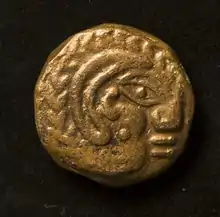23°23′34.16″N 58°31′7.70″E / 23.3928222°N 58.5188056°E

Photograph of the site

The imported tetradrachm confirmed as from the site
Al-Nejd is an archaeological site in Ash Sharqiyah, Oman. It was a fortified village inhabited during the Samad Late Iron Age and possibly during Islamic times. The site was discovered in 2014 following the chance find of a coin by a local resident, and was then confirmed and dated by a team from the Ministry of Heritage and Culture.[1] The site yielded an Abiel tetradrachm, struck in what is now the United Arab Emirates. The coin is on display in the National Museum in Muscat.[2]
Al-Nejd is fortified, has a garden and is directly near a water course (wadi), all characteristics of the Samad Late Iron Age.[3][4]
See also
References
- ↑
- Paul A. Yule, Valorising the Samad Late Iron Age, Arabian Archaeology and Epigraphy 27/1, 2016, 56‒58 Figs. 16‒19 ISSN 0905-7196.
- ↑ Jamal al-Musawi et al., The National Museum Sultanate of Oman Highlights, Muscat, 2016, p. 27 ISBN 978-1-78551-051-9
- ↑ Jürgen Schreiber, Transformationsprozesse in Oasensiedlungen Omans. Die vorislamische Zeit am Beispiel von Izki, Nizwa und dem Jebel Akhdar. Dissertation, Munich, 2007, pp. 62-64, URL http://edoc.ub.uni-muenchen.de/7548/1/Schreiber_Juergen.pdf
- ↑ Paul A. Yule, Cross-roads – Early and Late Iron Age South-eastern Arabia, Abhandlungen Deutsche Orient-Gesellschaft, vol. 30, Wiesbaden 2014, esp. 62-63 Table 5 (Pros and cons for theoretical premises for the existence of the Samad LIA), ISBN 978-3-447-10127-1, E-Book: ISBN 978-3-447-19287-3
External links
- Photographs from the Heidelberg University image database
This article is issued from Wikipedia. The text is licensed under Creative Commons - Attribution - Sharealike. Additional terms may apply for the media files.